Key takeaways:
- Investment risk analysis is crucial for making informed financial decisions and managing risks effectively through diversification and structured approaches.
- The process of risk assessment is akin to wearing a seatbelt, essential for protecting against unforeseen market fluctuations and reinforcing investment strategies.
- Understanding different types of risks, such as market, credit, and operational risks, is vital for informed decision-making and avoiding pitfalls in investments.
- Implementing strategies like diversification, maintaining cash reserves, and using stop-loss orders can significantly mitigate investment risks and improve overall portfolio resilience.
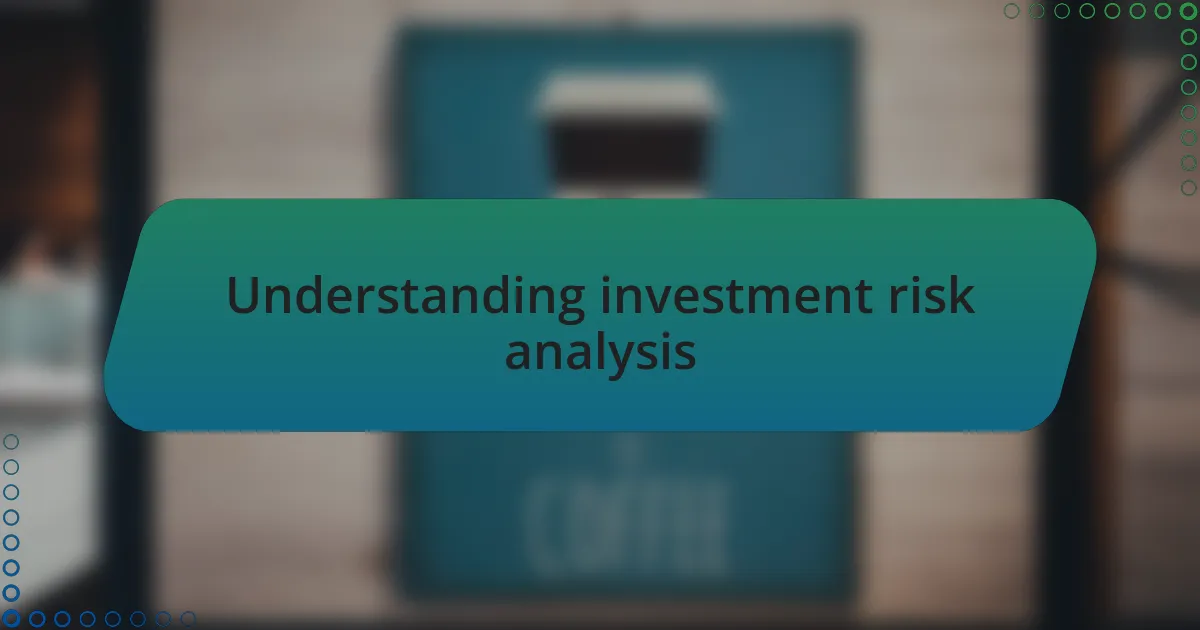
Understanding investment risk analysis
Investment risk analysis is like a compass guiding us through the sometimes treacherous waters of financial markets. I remember my first experience analyzing investment risks; it was daunting yet exhilarating. Every fluctuation in the market felt like a storm, but understanding risk analysis helped me navigate those challenges, making informed decisions instead of succumbing to fear.
When examining investments, I often find myself asking, “What could go wrong?” This question pushes me to dig deeper. I analyze factors like market volatility, regulatory changes, and even economic downturns. It’s fascinating how a small shift in one of these areas can significantly impact potential returns, teaching me valuable lessons about caution and preparedness.
One of my key insights is recognizing that no investment is without risk—the goal is to manage it effectively. I’ve learned that diversification plays a crucial role. By spreading investments across various asset classes, I could mitigate potential losses. This experience taught me that while risk can never be completely eliminated, understanding and analyzing it allows me to make choices that align with my financial goals.
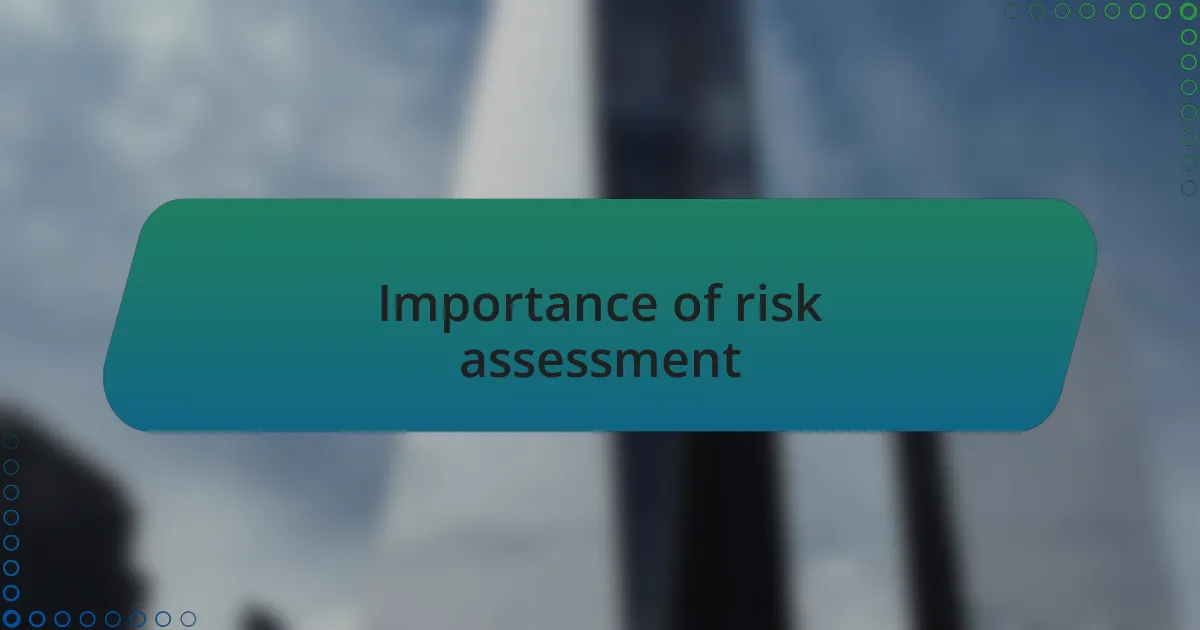
Importance of risk assessment
The process of risk assessment is essential in investment—it’s like wearing a seatbelt while driving. I recall a time when I neglected to fully assess the risks of a startup investment, influenced by excitement rather than careful analysis. The result? A harsh lesson in the reality of potential losses. This moment underscored the importance of having a structured approach to understand each risk element before I commit any resources.
Risk assessment serves as a shield against unforeseen market fluctuations. I often find myself looking back at investments that seemed promising but faltered because I overlooked critical risk factors, such as liquidity issues or geopolitical instability. Have you ever made a decision based on gut feelings alone? I have—and it didn’t end well. This realization drives home the necessity of diligent risk assessment to improve decision-making.
Moreover, evaluating risks helps reinforce my investment strategy. When I take the time to analyze possible outcomes, I can confidently position my portfolio to seize opportunities while safeguarding against downturns. It’s a balancing act, and I’ve learned that making informed choices based on thorough risk assessment not only boosts my financial health but also provides peace of mind amidst market chaos.

Types of risks in investments
Investing comes with various types of risks that can impact the performance of any portfolio. One risk I often encounter is market risk, which refers to the potential losses due to overall market fluctuations. I remember an investment I made during a market downturn; it was a stark reminder that external forces can influence even the most well-researched decisions. Does that make you cautious about how global events can affect your investments? It certainly does for me now.
Another critical risk is credit risk, which pertains to the possibility that a borrower may default on their obligations. I’ve seen this firsthand while evaluating corporate bonds. There was a time when I was tempted by high-yield bonds without fully understanding the issuer’s financial health. That experience left me vigilant about scrutinizing credit ratings and financial statements before diving in. Have you ever taken a leap only to find out later that the ground wasn’t as solid as you thought?
I also can’t overlook operational risk, which is the risk associated with failures in a company’s internal processes. I recall doing due diligence on a tech startup that promised great returns but had a shaky operational framework. I learned the hard way that backing a business without robust processes and experienced management can lead to unexpected pitfalls. What about you? Have you considered how a company’s internal workings could affect your potential gains? These types of risks highlight the importance of a comprehensive analysis before making investment choices.
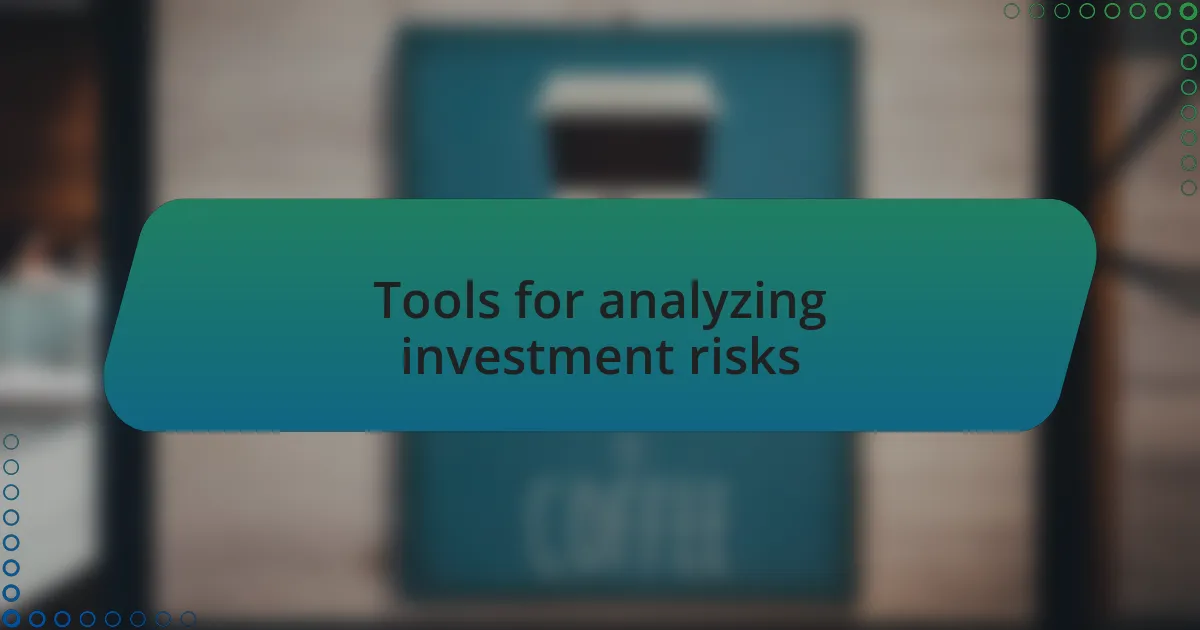
Tools for analyzing investment risks
When it comes to analyzing investment risks, one indispensable tool is the SWOT analysis—this stands for Strengths, Weaknesses, Opportunities, and Threats. I recall using this approach during a meticulous evaluation of a tech stock. It made me realize that while the company had innovative products, its heavy reliance on a single supplier was a glaring weakness that could jeopardize its growth. Have you ever overlooked a company’s vulnerabilities in your assessments?
Another valuable tool is the Monte Carlo simulation, which allows investors to model the probability of different outcomes in an investment scenario. I vividly remember applying this method when assessing a portfolio of real estate investments. The visualization of potential returns accompanied by corresponding risks helped me to see the range of expected outcomes more clearly. Does this kind of probabilistic thinking resonate with your investment strategy?
Finally, I can’t emphasize the importance of financial ratios, such as the debt-to-equity ratio, which provides insight into a company’s financial leverage. An instance comes to mind when I compared two companies within the same industry; one had a ratio twice as high as the other. This glimpse at their financial stability shifted my focus entirely when deciding where to allocate my funds. Isn’t it fascinating how such simple metrics can reveal the deeper financial health of a business?
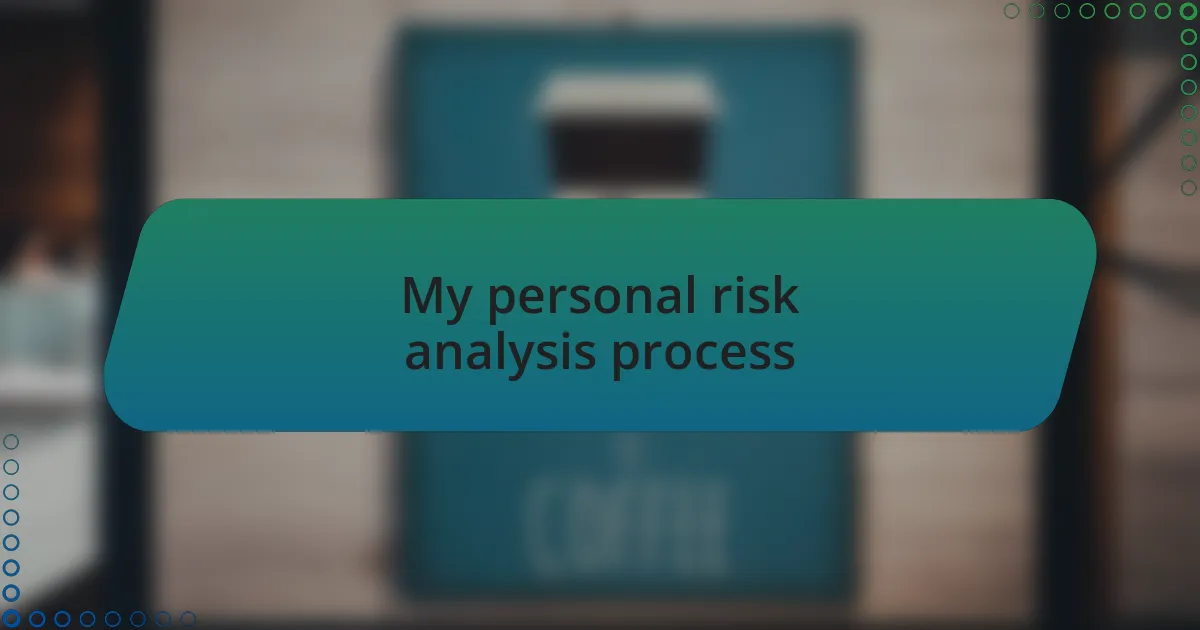
My personal risk analysis process
When I embark on my personal risk analysis process, I start with an introspective approach. I assess my risk tolerance by reflecting on my past investment experiences, both the successes and the setbacks. For instance, during a downturn in a previously promising market, I felt a wave of uncertainty. That experience taught me how vital it is to understand my emotional reaction to risks—do I retreat or seek opportunities?
Next, I dive into thorough research, balancing quantitative data with qualitative insights. This involves not just crunching numbers but also engaging with industry news and market trends. I vividly recall a time when I stumbled upon a niche market report that hinted at a disruptive innovation. My gut told me to act, and while the data was essential, it was that instinct mingled with informed research that led to a profitable investment. Have you ever experienced that blend of intuition and analysis?
Lastly, I often simulate different scenarios, imagining both best-case and worst-case outcomes for investments. I remember using this practice after a friend recommended a start-up. It felt exhilarating to visualize the immense potential, but also daunting to consider the risks. By mapping out what could happen in various scenarios, I feel more prepared. How do you ensure you’re ready for the unexpected in your investment journey?
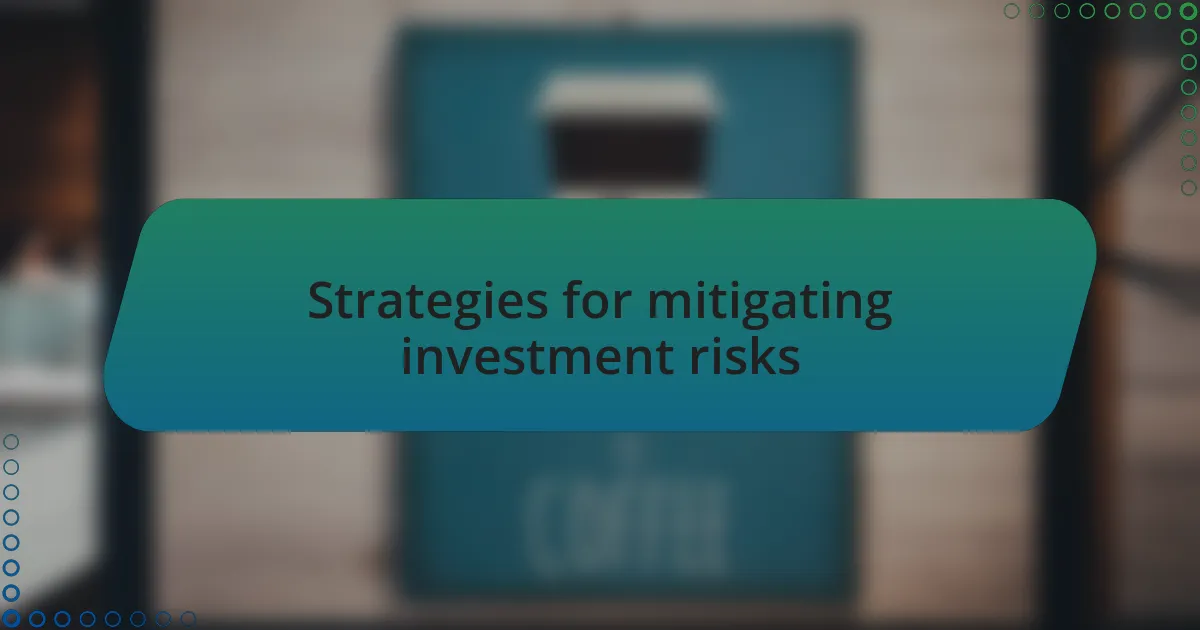
Strategies for mitigating investment risks
One effective strategy for mitigating investment risks is diversification. By spreading investments across various asset classes, such as stocks, bonds, and real estate, I reduce the likelihood of being severely impacted by any single downturn. I learned this lesson the hard way when I had a heavy concentration in one industry that crashed. The moment that happened, I realized the importance of a well-rounded portfolio—it’s like having multiple cushions to soften the fall.
Another approach I find invaluable is maintaining a cash reserve. Having liquidity on hand not only provides peace of mind but empowering opportunities as well. I vividly remember a time when a market correction presented a buying opportunity I couldn’t resist because I had cash set aside. I swooped in, and my willingness to act without financial strain made all the difference. Have you ever thought about how cash availability might enable you to capitalize on unexpected chances?
Finally, implementing stop-loss orders can also play a crucial role in risk management. These orders allow me to set predetermined sell points, which helps curb losses during market volatility. There was a challenging period when I had to execute a stop-loss on an investment I was emotionally attached to, but I knew it was a necessary move. It underscored the importance of discipline in trading; how do you balance your emotions with strategic decisions in your investment endeavors?
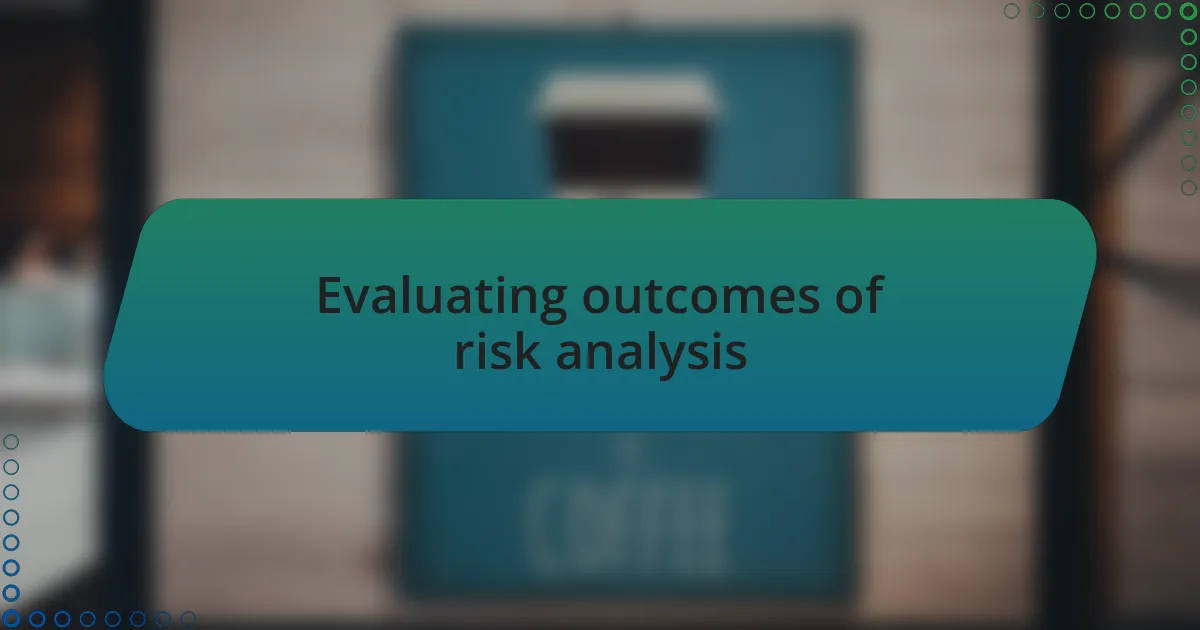
Evaluating outcomes of risk analysis
Evaluating the outcomes of risk analysis is essential to ensure that my investment strategies are both effective and aligned with my financial goals. When I assess the outcomes, I often refer back to my original risk assessments to determine if my predictions were accurate. I remember an instance when I underestimated the volatility of a stock and ended up reevaluating my initial analysis. Have you ever found your risk expectations mismatched with reality?
I also pay close attention to the lessons learned from each analysis. For instance, a recent investment didn’t perform as expected, which prompted me to dissect why my risk assessment fell short. Analyzing outcomes allows me to adapt and refine my approach, ensuring I’m not making the same mistakes. This process is like constantly tuning an instrument; each adjustment can lead to a more harmonious investment experience.
Moreover, I find it valuable to engage in discussions with fellow investors after a significant fluctuation. Exchanging insights helps me evaluate how others perceive risks and outcomes. I remember a roundtable conversation where a colleague shared a different perspective that shifted my viewpoint entirely. It’s fascinating how collective experiences can enhance our understanding of risk analysis. Have you ever changed your investment strategy after a conversation with someone who saw things from a different angle?